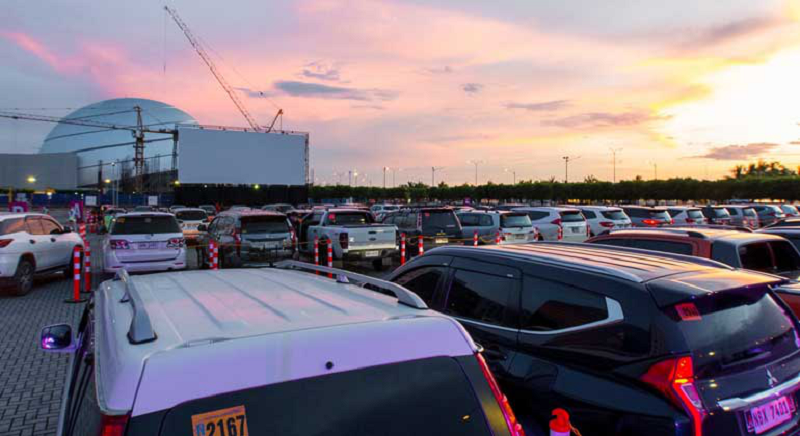
SM Drive-in Cinema
SIX MONTHS into lockdown and traditional cinemas are still not open because of health risks, but SM Cinema, arguably the largest cinema operator in the country, has found a modicum of success in introducing a new way of watching films outside one’s home in the relative safety of one’s car as after a pilot launch in SM Pampanga in late July, SM Cinema’s drive-in cinema has found its way to SM Mall of Asia (MOA).
Aptly called SM Cinemas by the Bay, the drive-in cinema is found at the SM MOA Concert Grounds (Block 16), with a perfect view of the Manila Bay. The one hectare parking lot can fit up to 106 cars per screening. Each vehicle can contain two to four people. Tickets, priced at P400, includes a popcorn bucket, beef franks, and bottled water.
Viewers can watch the films on a raised LED screen while audio is streamed via the cars’ radio through a specific FM frequency.
“The first SM Cinema Drive-in which was launched in Pampanga on July 31 drew an overwhelming reception from the public. Tickets were selling fast… There was a positive response from the public as it is an innovative, fun and safe way of watching movies,” Ruby O. Reyes, SM Cinema’s vice-president for marketing, told BusinessWorld in an e-mail interview on September 10.
But how was a cinema drive-in experience, really? According to Martin Marvin Macalintal, it was an “enjoyable experience,” but will not replace the experience in a traditional cinema as seeing a movie while inside a car does not provide the complete immersive experience one has in a regular cinema.
“The experience of a drive-in movie, there’s a distance from the screen, you’re not immersed into the screen because technically when you’re inside the cinema, everything is in total darkness… so you’re totally immersed and focused on to what’s happening on the screen,” Mr. Macalintal, cultural attache of the French Embassy in the Philippines, told BusinessWorld in a phone interview on Sept. 9. Among the embassy’s many projects he is involved in are the annual French Film Festival and the European Union’s CineEuropa.
Mr. Macalintal went to watch Train 2 Busan: Peninsula on Sept. 8 upon the invitation of SM Cinema.
The screening started at 6:30 p.m. though the parking lot opens earlier at 5:30 p.m., he recalled. Upon arrival, marshals were there to check the tickets (they are only bought in advance and not on-site) and the temperature of the person/s inside the vehicle. The vehicle also undergoes disinfection via a mister. After verification, the vehicle is led to a section where the viewer/s are given their food and drinks before being led to their designated parking space.
Mr. Macalintal was “seated” at the fourth row and reckoned that there were about 30 or so vehicles of people watching the film with him.
“The sound was clear: every sound effect, every explosion, everything was clean,” he said of the experience as the sound inside the car mimics a surround sound system.
“I enjoyed the experience because it’s actually something I wanted to do for the French Film Festival before,” he added.
And while a drive-in cinema cannot be a replacement for regular cinemas because it is not as immersive, Mr. Macalintal said that it’s an alternative, especially for an industry that has been one of the hardest-hit in the pandemic.
“To me, I think, the film industry is looking for alternative means of reviving the industry. The first and probably the last thing that will close and reopen would be the cinemas. So for half a year now, cinemas are closed worldwide so all these multi-million dollar/euro films are kept for next time. They are not making money,” he said, and as such, drive-in cinemas provide these films a way of being shown to a wider audience while still following health protocols.
“It’s an alternative, it’s not perfect but hey, [now] you can go out of your house and see a movie,” he added.